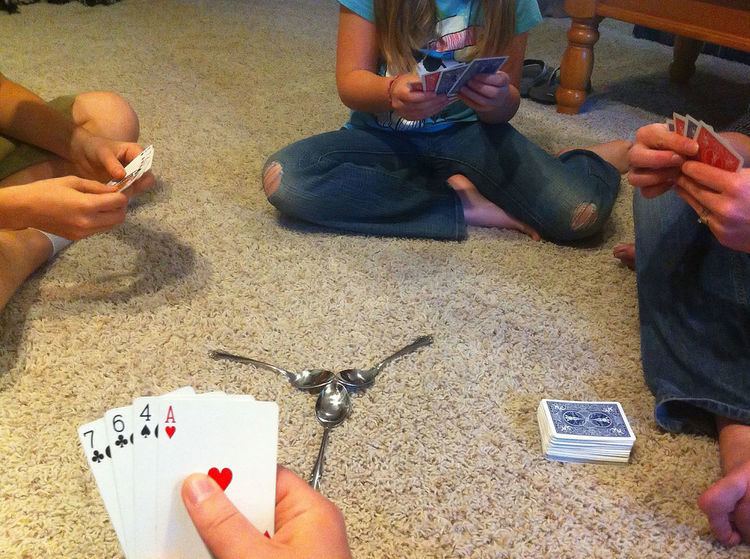Type Matching Age range any | Skills required Speed, Memorization Deck Anglo-American | |
 | ||
Players 3-6 (6-13 best, can have 13+ if varied) Playing time | ||
Spoons, also known as Pig or Tongue, is a fast-paced game of matching and occasional bluffing. It is played with an ordinary pack of playing cards and several ordinary kitchen spoons or other objects.
Contents
Spoons is played in multiple rounds, and each player's objective is to grab a spoon. No spoon may be grabbed until one player has collected a four of a kind, but once the first player to get a four of a kind has grabbed a spoon, all players may immediately reach out to attempt to grab a spoon. No player may grab more than one spoon at a time. As in the game musical chairs, there is always one fewer spoon than there are players, so one player will always be left without a spoon. Depending on the variety of game being played, that player either loses the game and is eliminated, or continues playing but loses a point.
Preliminaries
The game Spoons can be played with 3 or more players, using one or more decks of 52 ordinary playing cards and a number of spoons totalling one fewer than the number of players. Even though the game is famous for the usage of spoons, virtually anything can be used. The spoons are placed in the center of the table in a circle with handles pointing outward so that they may be easily grabbed by any of the players. One person is designated first dealer and deals four cards to each player. The dealer will use the remaining cards to draw from.
Play
Once everyone has picked up their cards, the game can begin. Each player is trying to make their four cards into a set of four of a kind (four queens, four twos, etc.) by drawing new cards and discarding ones the player deems useless to the current task.
The dealer draws the top card from the pile, and either discards it or exchanges it with a card in his hand, in which case he discards that card. Cards are typically discarded to the left. The next player picks up the dealer's discarded card, discards a card to the left, and play continues with the next player. The last player discards his card into a "discard pile", while the dealer continues to select cards from the original pile. A player is not allowed to place a discarded card in their hand until they have discarded one, so if they are slow, their piles could build up. No player may have more than 5 cards or fewer than 4 cards at any given moment. Players must hold their cards in their hand.
If the original pile of cards is exhausted without anyone having gotten their four-of-a-kind, the dealer begins drawing from the last player's discard pile.
Grabbing spoons
As soon as any player has a set of four of the same card, he or she takes a spoon. As soon as any other player notices that a spoon has been taken, he or she is allowed to take a spoon as well. This usually causes a mad grab for spoons leaving one player empty-handed, losing the round.
Scoring
There are two general ways of scoring Spoons. The first and simplest is that the loser of each round is immediately eliminated, and the next round is played with one fewer player (and one fewer spoon). The last remaining two people are declared the winners for quick games. (Although the game loses something of its elegance as a two-player competition, it is still technically playable if a single champion is desired.)
The long version of the game involves having the round's loser earn the letter "S" for their first loss, then at the next loss the letter "P", and so on gradually spelling out "S-P-O-O-N" (similarly to the basketball game H-O-R-S-E). When a player has accumulated all five letters in "spoon", they drop out of the game. At that time, the number of spoons used in game play is reduced by one. The game continues until only two people remain (or one, as above).
